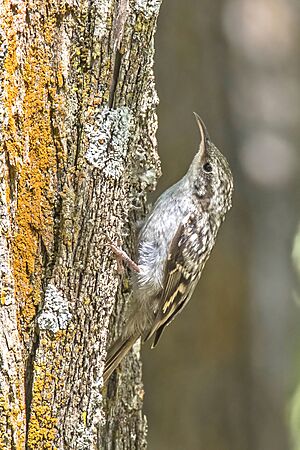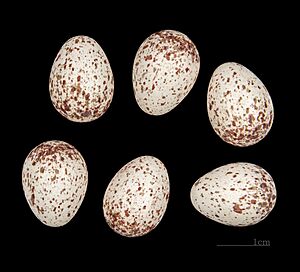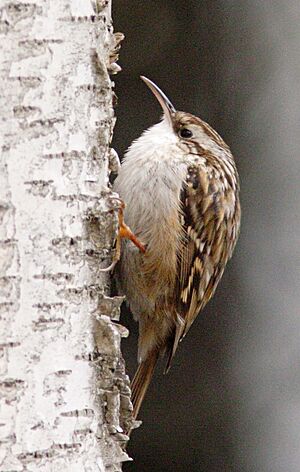Short-toed treecreeper facts for kids
Quick facts for kids Short-toed treecreeper |
|
|---|---|
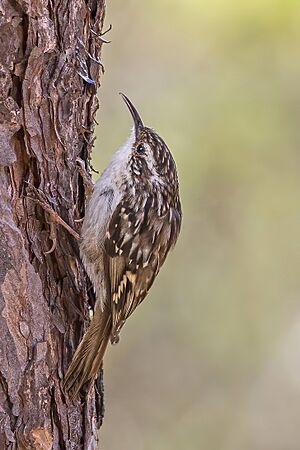 |
|
| Certhia brachydactyla megarhynchos, Spain | |
| Conservation status | |
| Scientific classification | |
| Genus: |
Certhia
|
| Species: |
brachydactyla
|
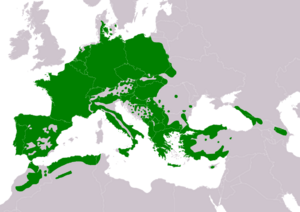 |
|
| Range of C. brachydactyla Resident | |
The short-toed treecreeper (Certhia brachydactyla) is a small passerine (a type of perching bird) that lives in woodlands. You can find it in warmer parts of Europe and into North Africa. It usually lives in more southern areas compared to another European treecreeper, the common treecreeper. Sometimes, it's hard to tell these two birds apart where they live in the same places. The short-toed treecreeper often prefers trees that lose their leaves (deciduous trees) and lower areas. Even though it mostly stays in one place, some birds have flown to new areas outside their usual homes.
The short-toed treecreeper is one of four very similar treecreeper species found around the world. This group includes the brown creeper from North America. There are five types (subspecies) of short-toed treecreepers, and they look and sound a bit different. Like other treecreepers, this bird has dull brown feathers on its back and white feathers underneath. It has a curved beak and stiff tail feathers. It lives in woodlands all year round and builds its nest in tree cracks or behind loose bark. It usually lays about six eggs. This bird is common and not very shy, but it can be hard to spot. It mainly eats insects, which it finds by hopping up tree trunks.
Contents
What is a Short-toed Treecreeper?
The short-toed treecreeper was first described by a scientist named Christian Ludwig Brehm in 1820. Its scientific name, Certhia brachydactyla, comes from Greek words. Kerthios is an old Greek name for a small tree bird. Brachydactyla means "short finger" or "short toe." This name refers to its shorter toes compared to the common treecreeper.
This bird is part of a group of very similar treecreeper species, all in the same family called Certhia. There are eight known species, which are divided into two main groups based on how they evolved. One group lives in the northern parts of the world (Holarctic), and the other lives in the Himalayas and nearby areas. The northern group, which includes the short-toed treecreeper, has a more musical song. The Himalayan species have a faster, trilling song. The short-toed treecreeper is in the northern group, along with the North American brown creeper and the common treecreeper.
Different Types of Short-toed Treecreepers
There are five different types, or subspecies, of the short-toed treecreeper. They are all very similar and can sometimes mix in areas where their homes overlap. Generally, birds in western Europe are paler and more reddish-brown, while those further east are darker. Here are the main types:
| Subspecies | Where it lives | What makes it special |
|---|---|---|
| Certhia brachydactyla megarhyncha | Channel Islands and western Europe (like Spain, France, Belgium, Netherlands, and western Germany). | These birds are paler and more reddish-brown than those further east. |
| Certhia brachydactyla brachydactyla | Central and eastern Europe, Sicily, and Crete. | This is the main type. It's darker brown on top and has clearer white stripes underneath than the western type. |
| Certhia brachydactyla mauritanica | North Africa. | It has darker brown upper parts and more buff (yellowish-brown) on its belly. Its song is different. |
| Certhia brachydactyla dorotheae | Cyprus. | It has greyer upper parts and very white underparts. Its song is also different. |
| C. b. harterti | Asia Minor and the Caucasus mountains. | It's similar to the western type but has duller reddish-brown upper parts. |
How to Identify a Short-toed Treecreeper
All treecreepers look quite similar. They are small birds with brown backs that have streaks and spots. Their rumps (the area above their tail) are reddish-brown, and their undersides are whitish. They have long, curved beaks and stiff tail feathers. These tail feathers help them lean against tree trunks as they climb up, looking for insects.
The short-toed treecreeper is about 12.5 centimeters (5 inches) long and weighs between 7.5 and 11 grams (0.26 to 0.39 ounces). Its upper parts are a dull grey-brown with detailed patterns of black, buff, and white. It has a faint off-white stripe above its eye and dull underparts, but its throat is white. Males and females look alike. Young birds have whitish underparts, sometimes with a buff-colored belly.
The call of this bird is a sharp, repeated tyt...tyt tyt-tyt. The song of the main type of short-toed treecreeper is a steady series of notes like teet-teet-teet-e-roi-tiit. Songs can vary a bit depending on where the bird lives. For example, birds in Cyprus have a very short and simple song, and those in North Africa have a lower-pitched song.
This species often lives in the same areas as the common treecreeper. The common treecreeper is usually whiter underneath and has warmer, more spotted feathers on its back. It also has a whiter stripe above its eye and a slightly shorter beak. However, it can be very hard to tell them apart just by looking, especially if the bird doesn't have clear markings. It's much easier to identify them by their calls or songs. The common treecreeper has a unique song with chirps and a final whistle, and it makes a shree call that the short-toed treecreeper rarely makes.
Where Short-toed Treecreepers Live
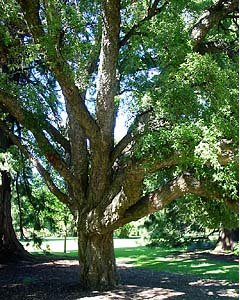
The short-toed treecreeper lives in temperate woodlands across Europe, from Portugal all the way to Turkey and Greece, and also in northwest Africa. It likes mature trees, especially oak trees, and avoids forests made only of conifer trees (like pine or fir). Where it shares its home with the common treecreeper in Europe, the common treecreeper tends to live more in conifer forests and at higher elevations.
This bird is usually found in lower areas. However, it can breed at higher places, up to 900 meters (2,950 feet) in Germany, 1,800 meters (5,900 feet) in France, and 1,400 meters (4,600 feet) in Switzerland. In Turkey and North Africa, it is a mountain bird.
The short-toed treecreeper generally does not migrate. But after breeding, some birds might move around and end up outside their usual range. They have been seen in places like England, Sweden, Lithuania, and the Balearic Islands.
Life Cycle and Habits
Reproduction
The short-toed treecreeper builds its nest in cracks in trees or behind loose pieces of bark. It might also use old woodpecker nests, cracks in buildings or walls, or even special nest boxes.
The nest usually has a bulky base made of twigs, pine needles, grass, or bark. It's lined with softer materials like feathers, wool, moss, lichen, or spider webs. The female lays eggs between April and mid-June, usually 5 to 7 eggs. The eggs are white with purple-red spots and are about 15.6 by 12.2 millimeters (0.61 by 0.48 inches) in size. The female sits on the eggs for 13 to 15 days until the chicks hatch. The chicks are born without feathers and need a lot of care. Both parents feed them, but only the female keeps them warm. The chicks leave the nest after 15 to 18 days. This species often has a second group of chicks in the same year. The male starts building a new nest while the female is still feeding the first group of chicks. When the first chicks are about 10 to 12 days old, the male takes over feeding them, and the female finishes the new nest.
Feeding Habits
The short-toed treecreeper typically looks for invertebrates (like insects and spiders) on tree trunks. It usually starts near the bottom of a tree and spirals its way up, using its stiff tail feathers for support. Unlike a nuthatch, it doesn't climb down trees headfirst. Instead, when it reaches the top, it flies to the bottom of another nearby tree. It uses its long, thin beak to pull insects and spiders out of cracks in the bark. While it usually feeds on trees, it sometimes looks for food on walls, on the ground, or among fallen pine needles. In colder months, it might also eat some seeds.
Daily Habits
The short-toed treecreeper is a small woodland bird with camouflage feathers and a quiet call, so it's easy to miss. It hops up vertical tree trunks like a mouse, moving in short jumps and using its stiff tail and wide feet for support. Even though it's hard to spot, it's not very shy and doesn't seem to mind people being nearby. It has a unique, wavy flight pattern, where it alternates between fluttering its wings like a butterfly and slipping or tumbling sideways. In winter, it lives alone, but when the weather is cold, more than twenty birds might gather to sleep together in a sheltered crack or under the eaves of buildings to stay warm.
Status and Conservation
The short-toed treecreeper lives in a very large area, covering between 1 and 10 million square kilometers (0.4 to 3.8 million square miles). It has a big population, estimated to be between 4.1 and 14 million birds. Scientists haven't seen a big drop in its numbers. Because of its wide range and large population, the IUCN Red List considers the short-toed treecreeper to be of "Least Concern." This means it's not currently at risk of disappearing.
It is common in most places where it lives, but it is rare in the Caucasus mountains and on the smaller Channel Islands. In the western part of its range, it has been spreading north through Denmark, where it first started breeding in 1946.



